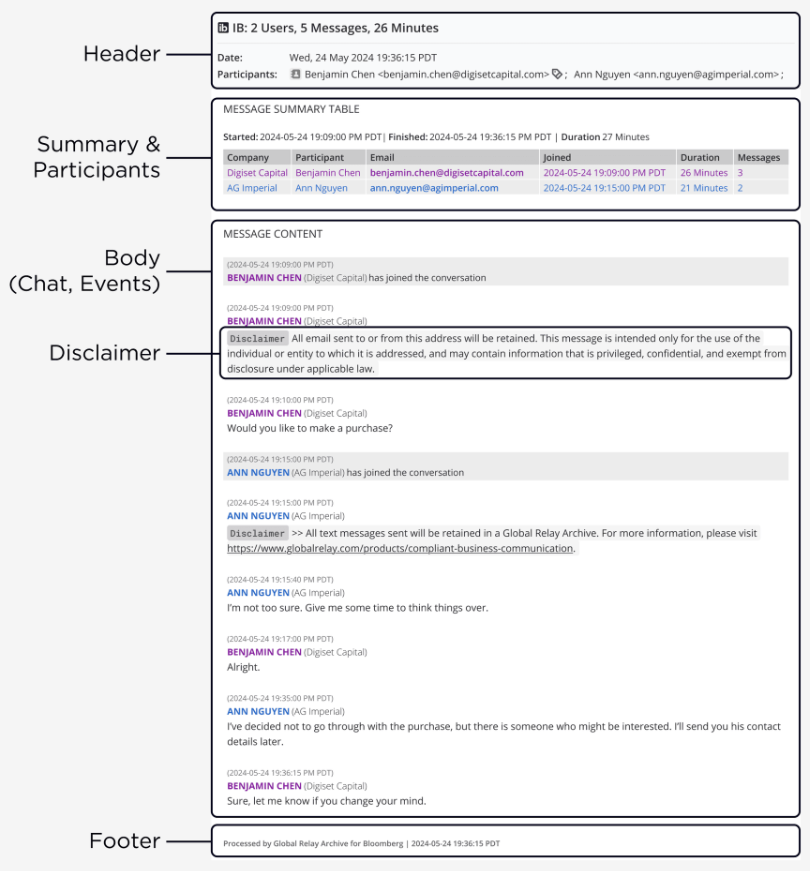More and more companies are looking to utilize artificial intelligence (AI) tools like Large Language Models (LLMs) to comb through the ever-increasing amount of communications data they’re expected to capture and archive. This new technology has the potential to greatly reduce surveillance workloads, yet AI tools like LLMs are only as strong as the data and prompts they work with.
Solutions like Unified Parsed Messages enrich comms data from channels as disparate as social media, hidden chats in trading venues, and ephemeral messages on both corporate and personal devices. By parsing and contextualizing data from these channels into a unified format, compliance teams can ensure AI tools are as efficient and accurate as possible.
Want to know how other surveillance teams are integration AI? Read our State of AI in Surveillance Report for 2025.
How Unified Parsed Messages organize communications data
Whether employees communicate through social media channels, video calls, or private messaging apps under bring-your-own-device (BYOD) policies, modern-day Connector solutions now capture that data for easy comms archiving. With terabytes of communications data captured by companies from so many different channels, it’s more important than ever to ensure data is being retained and archived in a clear, legible format.
The ability to format this varying data as UPMs presents myriad benefits, whether your team uses traditional lexicon analysis, LLM, or a combination of both to manage communication data. With UPMs, compliance teams can:
- Streamline workflows and spend less time deciphering vital context clues when manually reviewing flagged conversations
- Enable rule-based filtering to reduce noise and facilitate quick and efficient eDiscovery and legal holds
- Enhance the AI-powered tools a growing number of companies are using to upgrade traditional, lexicon-based surveillance methods
- Easily find incidents of misconduct in the event of a regulatory audit or internal investigation
Example: Email communications formatted via UPMs

Take emails for example. Email communications may contain file attachments of images and videos or feature emojis and other special characters interspersed throughout the message. There’s also duplicate content from repeated messages across long email threads and irrelevant data like uniform email signatures and disclaimers. Compliance teams need to archive these messages and ensure all potential risks are identified, but the intricacies of emails and custom simple mail transfer protocols (SMTPs) are one type of data among many used by employees.
Converting email communications into UPMs facilitates the structure and enrichment of these various elements into a standard format. Unstructured data is converted into a structured, compliant, EML format. The output includes fully annotated elements, such as headers, participants, message body, and disclaimers.
The “parsed” element of these unified communications refers to messages analyzed into labeled parts with syntactic roles described. It facilitates accurate cleanup in which noise is filtered out and boosts the precision and efficiency of AI analysis. On average, UMPs enable the size of email messages to be reduced by ~84% and chat and voice messages by ~99% before they’re analyzed by AI models.
How UPMs benefit compliance teams
Communications data enriched via UPMs helps boost the speed and accuracy of AI-powered surveillance tools. The removal of duplicated messages and irrelevant metadata from records like email communication also ensures surveillance LLMs are analyzing only high-quality data, improving efficiency.
With nearly one-third of surveillance professionals using or intending to use AI in the next year, and another third seriously considering AI implementation, structured and enriched data ensures AI-powered software is accurately and completely flagging and contextualizing cases. Anyone can leverage generative AI, and most can capture data from a range of communication channels, but UPMs help connect the two technologies and ensure both perform at their highest capabilities.
UPMs also enhance manual review conducted by legal teams or other business units investigating conversations that occurred across multiple dates and platforms. Parsed messages store layers of enrichments that can be presented to the end-user as overlays on the original message, helping reviewers to quickly find all relevant information and grasp the nuances of a flagged conversation.
Using UPMs to boost the performance of AI tools also helps surveillance teams understand how AI is analyzing their data. The inability to explain to regulators how and why AI has generated alerts is a significant pain point for most teams looking to adopt AI. Parsed and enriched data reduces the opacity of decisions made by AI, because all elements relevant to the flag are clearly labeled and contextualized.
Moving beyond data completeness to data comprehension
The Securities and Exchange Commission (SEC) recently released a proposal to establish new joint data standards under the Financial Data Transparency Act of 2022. The proposal would further require archived data submitted from companies to eight different regulatory bodies to be “fully searchable and machine-readable with clear structure and metadata,” among other standards. While these criteria won’t come into effect until early 2026, it signals rising expectations from the SEC for how companies store and organize their data.
Boosting accuracy, increasing efficiency, and meeting regulatory requirements, UPMs are a powerful tool to help companies make their data more uniform and accessible. They’re also a vital tool for any team looking to implement AI-powered surveillance.



